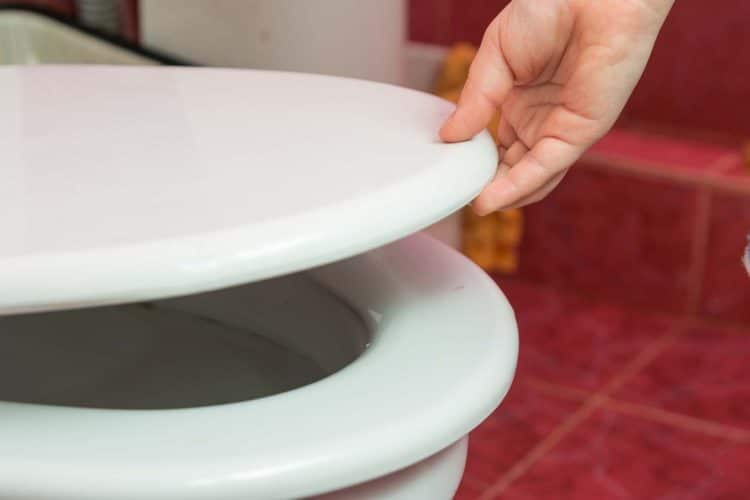No one wants to work on a toilet when the weekend arrives. Even other jobs on the to-do list are more inviting.
When you finally work up the courage to work on it, nothing is more frustrating than finding an uncooperative wing nut.
The bolts on a toilet often corrode beyond the point of saving. When plastic products are used to combat this problem, they can pick up nicks and dings that make the threads unusable.
Before you decide to put this chore back on your procrastination list, you have a few options to try to make quick work of this stubborn nut.
How to Remove a Rusted Wing Nut from a Toilet
The easiest way to remove a rusted wing nut that won’t move from a toilet is to cut the bolt away that holds it down. Since water exposure is a full-time issue with this hardware, it corrodes extensively. If there isn’t significant corrosion, a can of WD-40 can often loosen the nut so it can spin.
Rusted wing nuts are a common problem on toilets. They typically hold the toilet seat in place, but you can also find them on the main tank, the seat, and the floor.
Even though the bolts are plastic or galvanized, the moisture-rich bathroom environment causes the wing nut to seize. On older metal bolts and nuts, this issue is very common.
The first step to removing a rusted wing nut is to spray penetrating oil on the affected area. It takes a few minutes for the product to work its way to the surface to provide enough lubrication for movement.
If the wing nut refuses to move, hold the socket in place with a wrench while turning the wing nut from underneath.
Should those efforts be unsuccessful, the only other way to remove the wing nut from the toilet is to cut the bolt.
Best Options to Use for Removing a Rusted Wing Nut
The following methods are proven to work when you have a rusted wing nut that won’t spin. Although each option can help you be successful, the best choice often involves the tools you already have at your disposal.
Here are some ideas to try to repair your toilet.
Attack the Problem from Above
Although this option isn’t available for every toilet design, most bolts come with plastic caps or covers that protect them. After popping it off with a scraper or a screwdriver, you’ll have access to the working area.
First, try to spray a penetrating oil like WD-40 on the affected area. It needs about 15 to 25 minutes to work on the threads.
Once you’ve given it time to work, use a wrench or screwdriver to remove the bolt. You can use Vice Grips or other pliers to hold onto the wing nut while working.
If that doesn’t move it, you might be able to cut through the bolt or nut from above to remove the offending part.
Hold the Nut from Below
Depending on the part you’re trying to fix or replace, it might be possible to hold the wing nut from below while turning the bolt.
You’ll need to get down to ground level to look at the toilet’s issue from ground level. If you haven’t cleaned the area first, I highly recommend putting in a few minutes to do that first.
It’s not unusual for the bolt to turn with the wing nut when you’re trying to remove it. This issue happens because there isn’t anything to stop the movement.
Following these steps can help you solve this issue relatively quickly.
- Inspect the toilet’s underside to find the place where the bolts come through the top.
- Use an adjustable wrench or pliers to hold the wing nut in place.
- Take another wrench or a screwdriver to start loosening the bolt from the top.
If you’re dealing with a toilet tank issue, you will reverse the placement since the wing nuts would be on top and the bolts coming from below.
When you firmly keep the nut in place while loosening the bolt, you force the assembly to stop its freewheeling. That gives you enough torque to manage to break the wing nut away to continue with the repair.
Use Deep Sockets to Remove the Nut
It isn’t easy to get your hands on a toilet wing nut, especially when it is on the underside of the toilet. When your fingers or regular tools can’t reach the spot, you might have some success with a deep socket.
A deep socket connects to your ratchet or wrench, creating a tool that’s long enough to reach the core wing nut area. You’ll get enough leverage to start the loosening process. Keep going until you can spin it freely by hand or have it removed from the bolt.
This issue is one of the reasons why I keep the DeWalt 20-Piece Deep Socket set with my tools in the garage.
It uses knurled rings to reduce slippage for when you need to tighten or loosen bolts by hand.
The product comes with a removable internal tray for simple storage or to keep them in your regular toolbox.
Remove the Nut or Bolt with a Dremel Tool
When the wing nut doesn’t spin at all, the only solution is to cut it away. The easiest way to attack this problem is to have a Dremel tool available with a cutting blade.
Although copycat rotary tools are out worth considering, there is no comparison to the Dremel 8220. This 12V cordless design lets you get underneath a toilet with ease without worrying about contacting water and tripping the GFCI circuit.
It delivers the cutting power you need for a stubborn bolt, up to 35,000 RPM, while giving you slower speeds for plastic nuts and hardware that need to come off.
It takes about an hour to charge, but you’ll get enough energy to manage all the stubborn bolts without additional issues developing.
It works better to take a 45-degree angle when cutting through the nut and bolt. That’ll make everything easier to pull out once you finish the cutting work.
Use an Oscillating Tool to Cut the Bolt
Another way to cut through a stubborn bolt is to use an oscillating tool with a metal cutting blade. This option is a bit tricky because the size of the equipment can make it challenging to access the problematic hardware.
I highly recommend investing in the Dremel Multi-Max if you prefer this method. The 3.5-amp motor has plenty of power, allowing you to cut through nylon or metal with ease.
It uses an accessory system that promotes quick changes, allowing you to swap blades with minimal downtime.
You’ll receive up to 21,000 oscillations per minute at the fastest speed, but the soft grip on the auxiliary handle doesn’t cause premature fatigue.
You’ll receive nine sanding pads, a backing pad, and two cutting blades in the box.
The tool’s shape requires you to cut through the rusted nuts or bolts from the underside of the toilet.
If there is enough space, try to cut the bolt between the nut and the toilet to ensure it pulls out correctly once the work is finished.
You’ll need to be careful when using the oscillating tool to cut the wing nut. The blade moves from side to side when cutting, making it easier to snag the toilet’s side. If enough stress occurs, it could crack – and you’d be stuck installing a new toilet.
It helps to allow the tool to do most of the work when using this method.
Do I Need to Remove a Rusted Wing Nut from a Toilet?
Wing nuts affix specific accessories, features, or components to most toilets. When you need to update or replace these items, removal of the hardware is often necessary. The only other option is to cut through the bolt that holds things together, which means an added cost is necessary to complete the repair or update.
Back in my college days, I rented a small house on a dead-end street. I grabbed it because it had a huge backyard, a cheap price, and the property backed up to a Dairy Queen that stayed open 24 hours.
There was only one bathroom in the house, and the toilet had seen better days. I decided to invest in a padded seat for my one luxury item on a college kid’s income.
The old seat had metal bolts and wing nuts that looked like they hadn’t been touched since 1945.
My parents had given me a Dremel tool for Christmas, so I cut through them. It took four blades.
It was worth the effort. When it was time to move out, the property management agency charged me $50 to replace it, even though the seat was clearly newer than the previous one.
It was still worth it.
Although a miniature hacksaw can cut through a wing nut or a bolt, that should be your last option. Use the other ideas above first, and you should be able to have a successful toilet repair.

